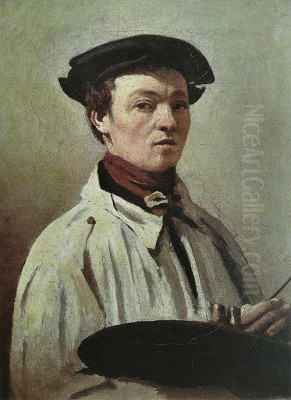
Jean-Baptiste-Camille Corot stands as a pivotal figure in the history of French art, particularly renowned for his sensitive and poetic landscape paintings. Born in Paris on July 16, 1796, and passing away in the same city on February 22, 1875, Corot's long and prolific career bridged the gap between the Neoclassical tradition and the burgeoning Impressionist movement. He was not only a painter but also a skilled sketch artist and printmaker, leaving behind a vast oeuvre that continues to captivate audiences with its subtle beauty and profound connection to nature. His influence extended far beyond his own canvases, shaping the course of landscape painting in the 19th century and beyond.
Early Life and Artistic Awakening
Corot was born into a prosperous Parisian family. His father, Louis-Jacques Corot, was a cloth merchant, and his mother, Marie-Françoise Oberson Corot, ran a successful and fashionable millinery shop. This comfortable bourgeois background provided financial security but didn't initially point towards an artistic career. Corot received a solid education but showed little aptitude for the commercial world his parents envisioned for him. He was apprenticed to cloth merchants, a path he followed dutifully but without passion.
Growing up partly within the lively environment of his mother's salon, interacting with clientele, may have helped shape his reportedly amiable and humorous personality, contrasting with a described shyness in his youth. Despite his lack of enthusiasm for business, he remained in the trade until his early twenties. It wasn't until 1822, at the age of 26, that Corot finally persuaded his parents to support his true calling. His father agreed to provide him with an allowance, enabling him to dedicate his life entirely to painting – a decision that would profoundly impact French art history.
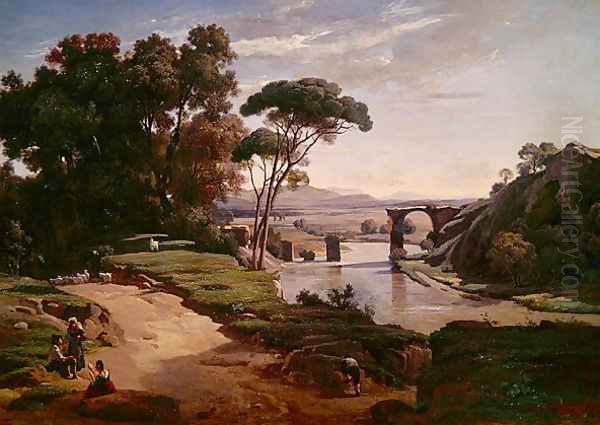
He began his formal art training under Achille-Etna Michallon, a promising landscape painter who sadly died young. After Michallon's death, Corot studied with Jean-Victor Bertin. Both Michallon and Bertin were proponents of the historical landscape tradition, rooted in Neoclassicism, emphasizing structure, clarity, and idealized views of nature often inspired by classical antiquity. This early training provided Corot with a strong technical foundation and an appreciation for compositional order, elements that would subtly underpin even his later, more atmospheric works.
Italian Journeys and Neoclassical Foundations
Like many artists of his time seeking to complete their education, Corot embarked on the traditional journey to Italy. He made three extended trips there during his lifetime, with the first, from 1825 to 1828, being particularly formative. Italy, with its classical ruins, sun-drenched landscapes, and rich artistic heritage, deeply impressed him. He spent his time sketching outdoors (en plein air), capturing the effects of light and atmosphere directly from observation, while also studying the works of Renaissance and Baroque masters.
During this first Italian sojourn, Corot produced numerous oil sketches that are now highly prized for their freshness, directness, and remarkable sensitivity to light and tone. These small studies, often painted rapidly on location, were distinct from the more finished, larger compositions he would later work up in his studio for Salon exhibitions. They reveal his innate talent for capturing the essence of a place and moment with startling immediacy.
One of the most significant works stemming from this period is The Bridge at Narni (1826). He painted an initial oil sketch on site, capturing the Roman aqueduct bathed in sunlight against the Umbrian hills. The following year, back in his studio, he created a larger, more finished version for the Paris Salon of 1827. While the Salon version adheres more closely to Neoclassical compositional principles, influenced perhaps by the likes of Nicolas Poussin, the initial sketch retains a vibrant, spontaneous quality that anticipates later developments in landscape painting. This work marked his successful debut at the Salon.
The Barbizon Connection and Plein Air Painting
Upon returning to France, Corot continued his practice of sketching outdoors, frequently traveling to different regions, including Normandy, Brittany, and the Forest of Fontainebleau near the village of Barbizon. Fontainebleau became a magnet for artists seeking a more direct and unidealized engagement with nature, moving away from the strictures of Neoclassicism. Though Corot never formally resided in Barbizon, he became closely associated with the group of artists known as the Barbizon School.
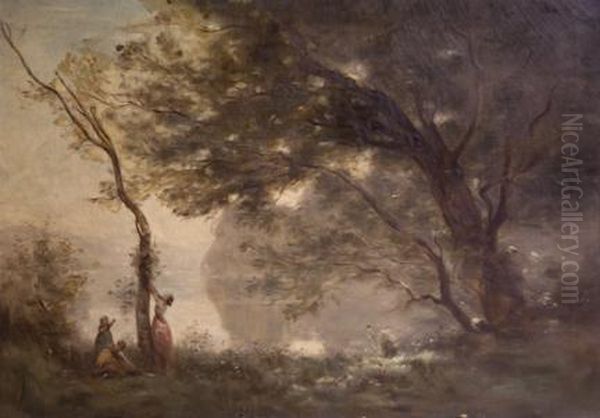
This informal group shared a commitment to realism and painting landscapes for their own sake, often working directly from nature. Corot formed deep friendships with key figures of the movement, notably Théodore Rousseau, whose own dedication to capturing the specific character of the French landscape likely influenced Corot's evolving aesthetic from the mid-1840s onwards. He also frequently traveled and painted alongside Charles-François Daubigny, another prominent Barbizon painter known for his river scenes often painted from a boat studio.
Corot's dedication to plein air sketching was fundamental to his practice. These outdoor studies informed the larger, more composed paintings he prepared for the Salon. While his finished Salon pieces often incorporated historical or mythological elements to meet academic expectations, their underlying structure and atmospheric truth were rooted in his direct observations of nature. This practice of outdoor work, focusing on the transient effects of light and weather, was a crucial precursor to the methods later adopted and expanded upon by the Impressionists.
Evolution of Style: Towards Poetic Realism
Corot's artistic style underwent a significant evolution throughout his long career. His early works, influenced by his Neoclassical training and Italian experiences, are characterized by clear drawing, precise details, relatively bright light, and structured compositions. Works like The Bridge at Narni exemplify this phase, balancing observed reality with classical compositional ideals.
From the 1840s and increasingly into the 1850s, Corot's style began to soften. His brushwork became looser, his palette more tonal, emphasizing subtle harmonies of grays, greens, and silvery blues. He became less concerned with topographical accuracy and more interested in capturing the overall mood and atmosphere of a scene, often bathed in the gentle light of dawn or dusk. This shift resulted in landscapes imbued with a lyrical, dreamlike quality, often described as poetic realism.
These later landscapes, such as Souvenir de Mortefontaine (1864), became immensely popular with collectors and the public. They evoke a sense of tranquility and nostalgia, featuring feathery trees whose leaves seem to shimmer in a soft, diffused light, often with small figures adding a touch of human presence but subordinate to the overall landscape mood. While some critics occasionally lamented a perceived repetitiveness or lack of definition in these later works, their evocative power and mastery of tone were widely admired. This signature style, with its emphasis on light and atmosphere over precise detail, directly paved the way for Impressionism.
Figure Painting and Portraits
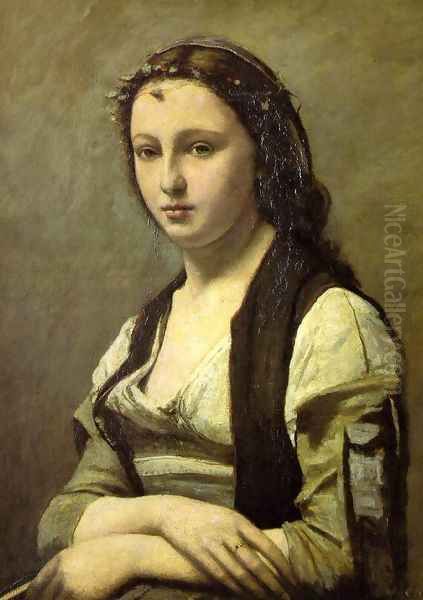
Although primarily celebrated as a landscape painter, Corot was also a masterful painter of figures and portraits, particularly later in his career. He produced around 300 figure paintings, many of which were personal studies not intended for public exhibition during his lifetime. These works often depict pensive women, dressed in studio costumes or contemporary attire, posed thoughtfully in interior settings.
Unlike his landscapes, which often aimed for a generalized, poetic mood, his figure paintings frequently possess a remarkable psychological depth and solidity. Works like Woman with a Pearl (c. 1868-70), despite its title likely being a misnomer (the "pearl" is probably a highlight on her forehead), showcase his ability to model form with sensitivity and capture a quiet, introspective mood. The influence of Italian Renaissance portraiture, perhaps Leonardo da Vinci or Raphael, can sometimes be discerned in the poise and structure of these figures.
He also painted portraits of friends and acquaintances. A notable example is his depiction of fellow artist Honoré Daumier in his Studio. These portraits, like his figure studies, reveal a different facet of his talent, emphasizing structure and individual character alongside his characteristic sensitivity to light and tone. His student, the Impressionist painter Berthe Morisot, was one of the few artists to whom he gave formal lessons, and his guidance likely extended beyond landscape to encompass figure work as well.
Later Years: Recognition and Legacy
Corot achieved significant recognition during his lifetime, though his greatest fame came relatively late. He exhibited regularly at the Paris Salon from 1827 onwards. While his early submissions were well-received, it was his evolving, more poetic style that eventually captured widespread acclaim. He won medals at the Salon in 1833, 1848, and 1855 (at the Exposition Universelle). A significant mark of official recognition came in 1846 when he was awarded the Cross of the Legion of Honour, a prestigious French order. Later reports suggest further honours, possibly a promotion within the Legion or another medal around 1874, acknowledging his esteemed position in the French art world.
Despite his success, Corot remained known for his modesty, kindness, and extraordinary generosity. Having inherited family wealth and earning considerable sums from his popular paintings, he lived simply and gave generously to charitable causes, particularly supporting struggling artists and their families. A famous anecdote recounts him buying a house for the caricaturist Honoré Daumier when Daumier was old and blind. His studio became a welcoming place for younger artists seeking advice.
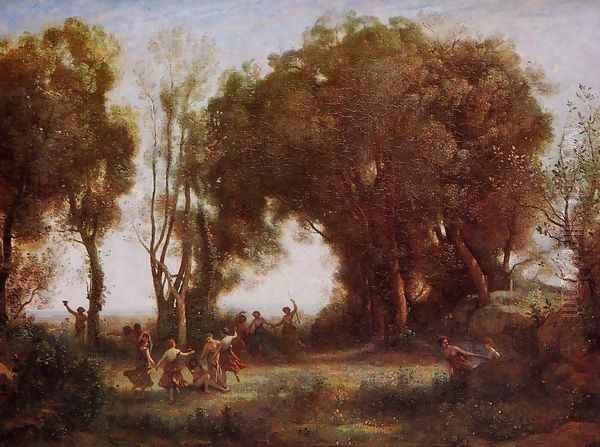
In his final years, Corot continued to paint with dedication, even as his health declined. When unable to travel easily in 1874, he turned his attention to still life painting. He passed away in Paris on February 22, 1875, from stomach cancer, at the age of 79. He was buried in the Père Lachaise Cemetery in Paris. His death was mourned by the artistic community, recognizing the loss of a beloved figure and a profoundly influential artist. He left behind an estimated 3,000 paintings, along with numerous drawings and prints.
Corot and His Contemporaries
Corot's long life placed him at the crossroads of several artistic generations, and he maintained relationships with a wide circle of artists. His early mentors, Michallon and Bertin, grounded him in Neoclassicism. His association with the Barbizon painters, including Théodore Rousseau and Charles-François Daubigny, was crucial to his development towards naturalism. His deep friendship with Honoré Daumier, despite their vastly different styles, speaks to his broad artistic sympathies.
He collaborated or interacted with various other artists. The painter Alexandre-Gabriel Decamps, also associated with Barbizon, created wood engravings based on a series of Corot's paintings titled The Four Times of Day. Corot's influence extended internationally; the Swiss painter Ferdinand Hodler, for instance, integrated elements of Corot's poetic classicism into his own distinct style. While traveling in Switzerland, Corot associated with local artists like Armand Leleu and Louis-Emile Giraud in Dardagny, engaging in discussions about technique.
His impact was also felt in Britain, where Arthur Douglas Peppercorn was dubbed "the English Corot," though Peppercorn sought a more dramatic effect compared to Corot's serene lyricism. Corot also engaged with younger artists, sometimes collaborating, as seen in his work with Pierre-Emmanuel Damoye. His role as a mentor, most notably to Berthe Morisot, further cemented his connection to the next generation, particularly the Impressionists.
Influence and Enduring Impact
Corot's position as a transitional figure between Neoclassicism and Impressionism is central to his historical importance. He absorbed the lessons of classical structure from masters like Poussin but combined this with an unprecedented dedication to capturing the fleeting effects of light and atmosphere directly from nature. His emphasis on tonal harmony over local color, his increasingly loose brushwork, and his commitment to plein air sketching provided a vital foundation for the Impressionists.
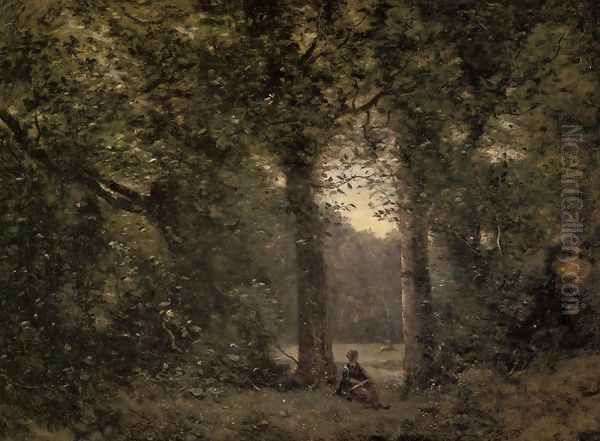
Artists like Claude Monet, Camille Pissarro, Alfred Sisley, and Berthe Morisot deeply admired Corot, affectionately calling him "Père Corot" (Father Corot). They learned from his approach to light and his ability to synthesize outdoor observations into cohesive studio paintings. Even Post-Impressionists like Paul Cézanne acknowledged Corot's importance, particularly his structural understanding combined with sensitivity to nature. While the Impressionists would push the study of light and color further, Corot's pioneering work opened the door for their innovations.
Beyond his technical influence, the sheer poetic beauty of Corot's landscapes secured his enduring appeal. He demonstrated that landscape painting could convey deep emotion and mood without relying on overt narrative or historical themes. His ability to infuse simple scenes of the French countryside with a sense of timelessness and gentle melancholy continues to resonate. He is rightly celebrated as one of the giants of 19th-century French painting, a master whose work seamlessly blends tradition and innovation.
Exploring Techniques: Cliché-Verre
Reflecting his curiosity and engagement with the visual technologies of his time, Corot also experimented with the cliché-verre process in the 1850s and beyond. This hybrid technique combines drawing and printmaking with photographic principles. Working with his friend, the photographer Charles Desavary, Corot would draw with a stylus onto a glass plate coated with an opaque ground (like collodion or varnish), essentially creating a hand-drawn negative.
This glass plate negative was then placed onto photosensitive paper and exposed to light, producing a positive print that replicated the artist's drawing with remarkable fidelity, capturing the linear quality of an etching but with a unique tonal softness. Corot embraced this technique, creating dozens of clichés-verre that often echo the subjects and atmospheric qualities of his paintings and drawings – landscapes, trees, and occasionally figures. This exploration demonstrates his openness to new methods of image-making and his consistent interest in capturing light and line. His work in cliché-verre represents a fascinating intersection of traditional art practices and the emerging medium of photography in the mid-19th century.